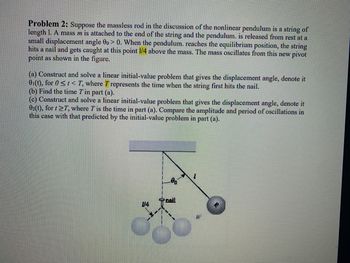Question
thumb_up100%
Q#2 Please solve correctly, NOT using Laplace method

Transcribed Image Text:Problem 2: Suppose the massless rod in the discussion of the nonlinear pendulum is a string of
length 1. A mass m is attached to the end of the string and the pendulum. is released from rest at a
small displacement angle 00> 0. When the pendulum. reaches the equilibrium position, the string
hits a nail and gets caught at this point 1/4 above the mass. The mass oscillates from this new pivot
point as shown in the figure.
(a) Construct and solve a linear initial-value problem that gives the displacement angle, denote it
01(t), for 0 <t< T, where T represents the time when the string first hits the nail.
(b) Find the time T in part (a).
(c) Construct and solve a linear initial-value problem that gives the displacement angle, denote it
02(t), for t2T, where T' is the time in part (a). Compare the amplitude and period of oscillations in
this case with that predicted by the initial-value problem in part (a).
00
nail
14
Expert Solution
This question has been solved!
Explore an expertly crafted, step-by-step solution for a thorough understanding of key concepts.
Step by stepSolved in 6 steps with 6 images

Knowledge Booster
Similar questions
- Problem 20.03 A proton traveling at 4.40 km/s suddenly enters a uniform magnetic field of 0.750 T, traveling at an angle of 55.0° with the field lines (see (Figure 1)). Figure 55.0⁰ Ł Proton B < 1 of 1 ▾ Part B Find the magnitude of the force this magnetic field exerts on the proton. Express your answer in newtons to three significant figures. ΑΣΦ F= Submit ▾ Part C Fmax = Submit V Part D 4 Request Answer If you can vary the direction of the proton's velocity, find the magnitude of the maximum force you could achieve. Express your answer in newtons to three significant figures. [V] ΑΣΦ ^ ? Request Answer 13 ? N ⒸE ? If you can vary the direction of the proton's velocity, find the magnitude of the minimum force you could achieve. Express your answer in newtons to three significant figures. VG] ΑΣΦ | € P Pearson Narrow_forward3 Consider a uniform source of particles inside a box with dx=8 cm , dy=4 cm, and dz=2 cm, centered on the origin. Use hand calculation to model each of the sources (3D, 2D-rectangular x-y, 1D linear x, point at origin) and compare the total flux at distances of 1, 2, 64, and 256 cm above from the origin (in the z direction).arrow_forwardAnswer all parts of the physics problem pleasearrow_forward
- Draw the free body diagram for the charge C showing the superposition of forces FC= FA + FB. Calculate the net force (magnitude and direction) on the charge labeled C at the far right.arrow_forwardProblem 1 (25%) An infinite plane slab of thickness 2d (the slab is located between z=-d and z=d) carries a uniform volume charge density p. Using the Gauss's law, find the electric field as a function of z inside and outside the slab. Plot schematically the dependence of the electric field as a function of z. 2d $000arrow_forwardcan you solve only d pleasearrow_forward
arrow_back_ios
arrow_forward_ios